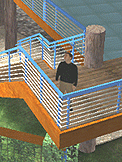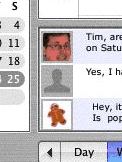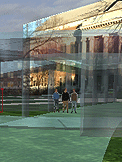
|
||||||||||
|
|
|
|
|
|
|
|
||||
|
|
|
|
||||||||

|
|
Community Services: Overview: A true community discourse Minneapolis has a tradition of fostering social, artistic and educational dialogues through community programs, arts and outreach. Wireless networks provide community members with new opportunities to expand this discourse within the local community. We term such programming-related content "Digital Community Access Programming", or DCAP for short.
Commonly, Web sites limit their level of interactivity to simple navigations. A truly dynamic interactive capability would be like a conversation. Web content is only one manifestation of the protocols that underlie the Internet. Other protocols make possible chats, instant messaging, email, and FTP for upload/downloading files. Online communities can take advantage of these dynamic environments. For example, collaborative tools allowing users to share and edit files simultaneously, chat, even teleconference. Online games with virtual 3D engines allow users to interact virtually in real time over networks.
The educational outcomes of our World Class Initiative are just one possibility for new tools and activities. Here are some others: a) Collaborative Projects - If a wireless network user wanted to organize work parties for a community garden plot, they might list the project online and request interested community members to sign up for tasks such as procuring organic fertilizer, tilling, and providing refreshments for the work party. This can all be done online. Refer to Wikipedia for general definitions of collaborative software. b) Performance - Digital artists, playwrights and musicians could create near real-time collaboration between artists and audience in a new model of community participation. Participants may sample a live music performance, modify it, then play it back as a duet with the musician during the performance. Or, a director may stage a play about the Grand Canyon and have members of the community upload photographs from their Grand Canyon vacations over the Internet during the play. The images would be screened for content and projected onto the play's scenery in real time. c) Virtual Space Review for Public Spaces - Providing venues for public commentary on public building designs is essential to good stewardship of the city. However, the public isn't always successful visualizing from 2D renderings. So allow interested parties to visit the site with Wi-Fi enabled laptop and see the building in 3D superimposed on the site. This can be accomplished using either virtual worlds or mobile "augmented reality" (AR) mixing real and virtual imagery. AR has also been demonstrated on mobile "smart" phones with cameras. d) Hyper-local social networking - Online social networking services commonly identify other individuals with shared interests. Wireless allows individuals in close proximity to each other to compare shared interests. One example is Jambo Networks (a speaker at our 2005 conference). e) Mobile Weblogs (Moblogs) - This includes new models of reporting and journalism typified by Mobile Web Logging (Moblogs). Wireless technologies provide the opportunity to report from remote locations using text, audio or video blogs using WiFi-ready Web cams. For example, a blogger may feed live video to a weblog while community members simultaneously upload personal photographs, viewpoints and data adding to the depth of the report. f) Open Play - Games and simulations are an important part of digital learning. Beth Noveck, a professor of law at New York Law School states, "My supposition is that virtual worlds are going to be the best training ground for teaching the practices of democracy ... they offer a playground for complex social interactions and collaborative decision making, according to a set of rules defined by the game space". With a mobile network, games need not confine the user to home. They can lead a player through the corridors of city hall to see where and how a permit is obtained, or guide and educate players in the outdoors while learning about the flora and fauna of the parks system. g) Legacy Content - Legacy versions of outstanding past educational software titles, even those not developed for the Web, could be made available to network subscribers. To achieve this the local WISP would collaborate with local public broadcasters, museums, and learning centers on providing legacy content to children and the general public. |
|
|||||||

|
|
|||||||||
|
|
||||||||||
|
[ About Us | How We Work | Community Services | Minneapolis RFP | Downloads | Contact Us ] Spotlight NEW:The World Class Initiative "Wireless Cities — Communities of Interests" "Wireless Cities — Community Context"
Virtual Architecture
Legacy E-learning Other Images to See
Community Project
Virtual Architecture
|
||||||||||
|
|
|
|
|
|
|
|
|
|
|
|



